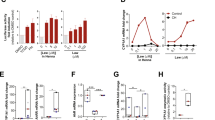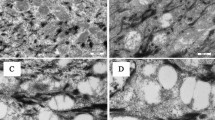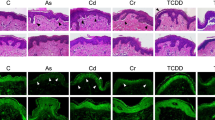Abstract
WHEN the skin of the mouse is painted with a benzene or an acetone solution of a carcinogenic hydrocarbon, it is found afterwards that a part of the carcinogen remains in the keratinized layer of the epidermis, while some of the carcinogen (fluorescent material) immediately enters the pilo-sebaceous apparatus and is found dissolved in the lipid droplets within the gland cells. Several authors have suggested that the pilo-sebaceous apparatus plays an important part in the genesis of skin cancer by providing channels through which the carcinogen may penetrate the epidermis1. It was thought that a study of carcinogenic action on new-born mice2,3,4 would throw light on this problem, for it has been observed that newborn mice (2–10 hr. after birth) are refractory to a single application of methylcholanthrene. The absence of sebaceous glands, the lack of a way of entering via the hair follicles and also the thicker epidermis of new-born mice, confirmed by histological examination, would explain ineffectiveness of methylcholanthrene for tumour formation. The literature does not seem to contain any convincing evidence that the carcinogen is absorbed by the epidermal epidermis without mediation of the follicular pathways.
This is a preview of subscription content, access via your institution
Access options
Subscribe to this journal
Receive 51 print issues and online access
$199.00 per year
only $3.90 per issue
Buy this article
- Purchase on Springer Link
- Instant access to full article PDF
Prices may be subject to local taxes which are calculated during checkout
Similar content being viewed by others
References
Simpson, W. L., and Cramer, W., Cancer Res., 3, 515 and 362 (1943); 5, 5 (1945).
Suntzeff, V., Carruthers, C., and Cowdry, E. V., Cancer Res., 7, 439 (1947); 8, 390 (1948).
Lacassagne, A., and Latarjet, R., Cancer Res., 6, 183 (1946).
Cowdry, E. W., and Suntzeff, C., Yale J. Biol. and Med., 17, 47 (1944).
Setälä, K., Acta Path. Scand., 26, 280 (1949).
Setälä, K., Ann. Med. exp. Fenniœ, 26, 126 (1948).
Setälä, K., Acta Path. Scand., 26, 223 (1949).
Ekwall, P., VI Nordiska Kemistmötet, 179 (Lund, 1947).
Ekwall, P., and Setälä, K., Acta Chem. Scand., 2, 733 (1948).
Ekwall, P., and Setälä, K., Acta Path. Scand., 26, 795 (1949).
Setälä, K., and Ekwall, P., Acta Path. Scand., 26, 804 (1949).
Setälä, K., and Ekwall, P., Ann. Med. Exp. Fenniœ (in the press).
Author information
Authors and Affiliations
Rights and permissions
About this article
Cite this article
SETÄLÄ, K., EKWALL, P. Penetration of Benzpyrene through the Intact Skin of New-Born Mice. Nature 166, 188–189 (1950). https://doi.org/10.1038/166188b0
Issue Date:
DOI: https://doi.org/10.1038/166188b0
This article is cited by
-
Experimental Chemical Carcinogenesis and the Influence of Solvents: Research in Finland
Nature (1954)
-
The Penetration of Fat and Fatty Acid into the Skin of the Rat*
Journal of Investigative Dermatology (1953)
Comments
By submitting a comment you agree to abide by our Terms and Community Guidelines. If you find something abusive or that does not comply with our terms or guidelines please flag it as inappropriate.



